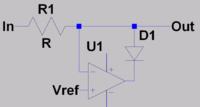bmandl
Full Member level 4

- Joined
- Feb 26, 2010
- Messages
- 210
- Helped
- 3
- Reputation
- 6
- Reaction score
- 3
- Trophy points
- 1,298
- Location
- Slovenia
- Activity points
- 3,006
Hello!
I am designing voltage sensing circuit for 0-100V DC input with voltage divider at aprox. 5V output. But my requirements are, that anything higher than exactly 5V at output shouldn't go further to the ADC. I want to make some kind of a voltage follower and voltage limiter for anything higher than 5V. If there comes signal, higher than 5V, I want to drop that voltage across some resistor and LED for indication. Can I make circuit with decent accuracy with opamp, and how? I drew some kind of a block diagram.
**broken link removed**
I am designing voltage sensing circuit for 0-100V DC input with voltage divider at aprox. 5V output. But my requirements are, that anything higher than exactly 5V at output shouldn't go further to the ADC. I want to make some kind of a voltage follower and voltage limiter for anything higher than 5V. If there comes signal, higher than 5V, I want to drop that voltage across some resistor and LED for indication. Can I make circuit with decent accuracy with opamp, and how? I drew some kind of a block diagram.
**broken link removed**








